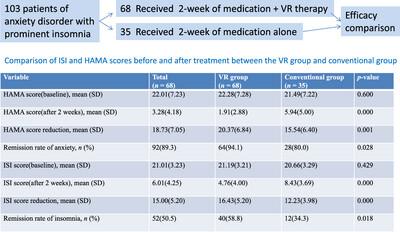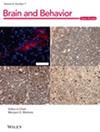Acute Augmented Effect of Virtual Reality (VR)–Integrated Relaxation and Mindfulness Exercising on Anxiety and Insomnia Symptoms: A Retrospective Analysis of 103 Anxiety Disorder Patients With Prominent Insomnia
Abstract
Background
Anxiety disorder is one of the most common mental disorders and often accompanied with sleep disturbance which can in turn exacerbate anxiety symptoms, creating a vicious cycle. In addition to psychopharmacological therapy, the effectiveness of psychotherapy as cognitive behavioral therapy (CBT) for treating anxiety disorders and insomnia has been well documented and widely accepted, but it is labor-intensive and costly. However, virtual reality (VR)–integrated CBT may improve this condition but needs more evidences to support its extensive application in routine clinical practice.
Objectives
This explorative study was aimed to conduct a retrospective analysis to evaluate the acute (2 weeks) augmented effect of VR-integrated relaxation and mindfulness exercising in improving anxiety and insomnia symptoms for patients who were diagnosed with anxiety disorders and concurrently with prominent insomnia symptoms and admitted to the Department of Psychiatry, The Affiliated Guangdong Second Provincial General Hospital of Jinan University during January 2021 to June 2021.
Methods
All patients who were admitted to the department of psychiatry during January 1, 2021 to June 30, 2021 were screened with inclusion criteria and exclusion criteria, and the sociodemographic and clinical data of those included patients were collected from the electronic medical record system of the hospital using a self-designed case report form (CRF). Subjects who were administrated with medication alone were designated as conventional group, and those receiving treatment of medication combined with VR-integrated CBT (VR relaxation and mindfulness exercising) as VR group. The baseline and 2-week posttreatment data were compared between the two groups.
Results
In total, there were 103 patients (70 female, 68%) included in the study. Among all, 68 (66.02%) were designated as the “VR group,” and 35 (33.98%) as the “conventional group.” The majority of patients (67%) were diagnosed with generalized anxiety disorder (GAD). Twenty-three (22.3%) patients had a comorbid diagnosis with primary insomnia, and insomnia was just one of the accompanying symptoms with anxiety for the rest 80 subjects. No statistically significant differences were found between VR and conventional groups in all baseline sociodemographic and clinical characteristics except for occupation. There were statistically significant differences for the remission rates of anxiety symptoms or insomnia symptoms and reduction of Hamilton Anxiety Rating Scale or Insomnia Severity Index total scores between conventional and VR groups. Greater remission rates or score reductions were found in VR group than in conventional group either for anxiety or for insomnia. Robust differences still existed when controlled for the variable “occupation.”
Conclusions
Two-week augmented VR-integrated relaxation and mindfulness exercising is acutely beneficial for relieving both anxiety and insomnia symptoms and worth being recommended for routine clinical practice. Further prospective and randomized study compared to traditional CBT to explore its acute and long-term effect on anxiety and insomnia is needed.


 求助内容:
求助内容: 应助结果提醒方式:
应助结果提醒方式:


